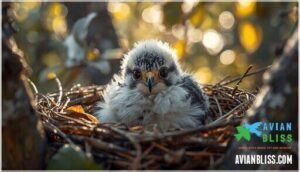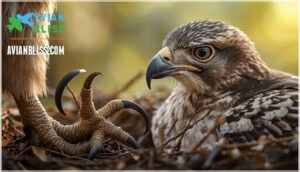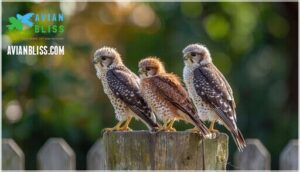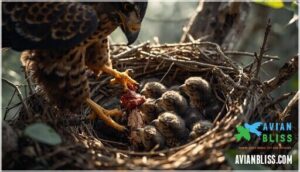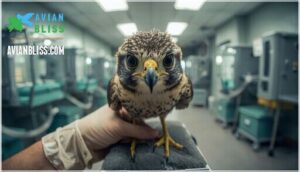This site is supported by our readers. We may earn a commission, at no cost to you, if you purchase through links.
 A pale, fluffy ball of down perched in a nest doesn’t look much like the powerful predator it will become. Baby hawks start life as helpless hatchlings, covered in soft white or grey feathers, relying completely on their parents for food and protection.
A pale, fluffy ball of down perched in a nest doesn’t look much like the powerful predator it will become. Baby hawks start life as helpless hatchlings, covered in soft white or grey feathers, relying completely on their parents for food and protection.
These young raptors grow rapidly, developing their hunting instincts and distinctive features over just a few weeks. Understanding what baby hawks look like, what they eat, and how to respond if you find one can help you make the right decision if you encounter these vulnerable birds in the wild.
Table Of Contents
- Key Takeaways
- What Do Baby Hawks Look Like?
- How to Tell Baby Hawks Apart
- What Do Baby Hawks Eat?
- What to Do if You Find a Baby Hawk
- Raptor Rehabilitation
- Frequently Asked Questions (FAQs)
- What should I do if I find a baby hawk?
- What is a baby hawk called?
- What do baby hawks eat?
- What is a baby red tailed hawk called?
- Are baby hawks cute?
- What does a baby hawk look like?
- When do baby hawks take flight?
- How do you identify a baby hawk?
- What should you do if you find a baby hawk?
- Can a hawk pick up a 10 lb cat?
- Conclusion
Key Takeaways
- Baby hawks hatch covered in white or gray down feathers and rely entirely on their parents for food, which progresses from regurgitated meals to whole prey as they develop their hunting skills over six to seven weeks.
- You can identify juvenile hawks by their fluffy appearance, disproportionately large yellow feet and curved beaks, high-pitched whistling calls, and mottled brown plumage that differs from the bold coloring of adult birds.
- If you find a baby hawk, don’t handle it yourself—contact a licensed wildlife rehabilitator immediately and keep the bird in a dark, quiet place to prevent stress and imprinting on humans.
- Professional raptor rehabilitation requires federal and state permits, specialized training, and careful techniques like puppet feeding to ensure orphaned hawks develop proper wild instincts and survive after release.
What Do Baby Hawks Look Like?
When you spot a baby hawk for the first time, you might be surprised by how different it looks from the sleek, powerful adult birds you’re used to seeing. These young raptors have distinct physical features that set them apart and make identification easier.
Here’s what to look for when trying to recognize a baby hawk.
Covered in White or Grey Fluffy Down Feathers
When baby hawks hatch, they’re covered in soft down feathers—white or gray plumage that plays a huge role in their survival. This downy layer isn’t just for looks; it’s a specialized insulation system that traps air close to their bodies, keeping them warm when they can’t regulate their own temperature yet.
Here’s what makes this fuzzy coat so critical:
- Down composition: Made of loosely arranged beta-keratin barbs that boost heat retention
- Thermoregulation role: Prevents heat loss during early growth stages when metabolic control is still developing
- Color variations: White down is typical in red-tailed hawks, while gray appears in some falcon species
This fluffy appearance helps with baby hawk identification and camouflage in the nest during vulnerable growth stages. These baby birds, also called need parental care, because they’re altricial.
Mature Feathers Emerge Through Down as They Age
Around two weeks after hatching, you’ll notice something striking—feather development begins to transform your baby hawk from a fluffy puffball into a sleek raptor. Flight feather emergence starts around day 13 when tail tips break through the down, followed by wing feathers at roughly 27 days. This molting process continues until week 5 or 6, when juvenile plumage camouflage patterns become visible:
- Dark pin feathers poke through like tiny quills
- Brown and black plumage gradually replaces white down
- Wing feathers grow in balanced pairs for future flight
- Mottled patterns provide nest protection
This process of feather replacement is known as prebasic molt. By 39 to 56 days, hawk development reaches a turning point—complete feathering that makes flight possible.
Large Curved Beak and Large Feet
As feathers fill in, you’ll notice the hooked beak becomes more pronounced—a specialized tool for tearing prey. Juvenile red-tailed hawks sport beaks measuring 14.7–17.6 mm, perfectly curved for their predatory future.
But it’s the feet that really grab your attention. Baby hawks hatch with disproportionately large talons, with the longest claw reaching over 20 mm in some species. This rapid foot growth during the first three to four weeks isn’t random—it’s an evolutionary trait that gives young raptors their grip strength early, preparing them to handle prey before they’ve even left the nest.
Baby hawks hatch with oversized talons—an evolutionary head start that builds grip strength for hunting before they ever leave the nest
Yellow or Light-colored Feet
You’ll spot the feet right away—they’re bright yellow or pale greenish-yellow when hawks first hatch. This foot color timeline marks early development stages. Here’s what baby hawk identification reveals:
- Pale yellow-green feet signal newly hatched Cooper’s Hawks and Red-tailed Hawks
- Carotenoid influence from prey deepens color as they mature
- Species comparison shows Harris’s Hawks follow similar patterns
- Camouflage adaptation helps nestlings blend with bright nest materials
- Health indicator: vivid hues suggest strong diet and proper growth
Identifying baby hawks gets easier when you track how juvenile hawk identification relies on these light tones shifting toward adult orange-yellow over their first year.
How to Tell Baby Hawks Apart
Once you know what baby hawks look like, you’ll want to figure out which species you’re observing.
Telling different hawk species apart as babies can be tricky, but there are a couple of reliable clues. Here’s what to look and listen for.
Look Like Miniature, Pale and Downy Versions of Parents
When you observe a juvenile hawk next to its parent, you’ll notice it looks like a smaller, softer version of the adult bird. Baby hawk appearance changes dramatically during nestling stages, though initial resemblance to parents is clear from the start. These hawk chicks share the same basic body structure but appear fluffier and less defined.
Here’s what helps with baby hawk identification:
- Nestling plumage shows light brown chests with mottled speckling instead of bold adult coloration, and their down creates softer contours around their body.
- Juvenile hawks display brown-striped tails rather than the uniform rusty red of adult red-tailed hawks, which remains until their first molt around one year post-fledgling.
- Eye color stays pale yellow for months after fledgling stages begin, while adults show brown or reddish eyes, making this a reliable identification marker.
Facial down around their eyes and mouth persists briefly during baby hawk development, distinguishing them during nestling care periods when parental influence shapes their survival skills. Feather growth progresses rapidly as they mature.
Make High-pitched Whistling or Piping Calls
You’ll recognize juvenile hawks by their distinctive vocalization patterns—persistent, high-pitched whistles that sound like "wee-EEE, wee-EEE." These fledgling calls function primarily as food-begging signals during hawk communication with parents.
A baby hawk’s auditory development produces calls ranging between 5 to 8 kHz, noticeably higher than the adult’s lower-pitched scream. These whistling behaviors peak during morning feeding times, when hungry hawk fledglings may vocalize over ten times per minute.
As your juvenile hawk matures and gains hunting independence, this characteristic piping gradually transitions toward the iconic adult scream you’re familiar with.
What Do Baby Hawks Eat?
Understanding hawk diet and nestling nutrition helps you appreciate these exceptional hunters. When you watch a hawk nest, you’re witnessing an impressive feeding operation in action.
Baby hawks rely entirely on their parents for their raptor meals during early development. Here’s how the baby hawk feeding process unfolds:
- First two weeks: Parents deliver regurgitated food every 1–3 hours, providing pre-digested protein that’s easy for hatchlings to swallow
- Weeks three through five: Adults tear fresh prey—mice, voles, small birds, and insects—into bite-sized strips for growing nestlings
- Week six onward: Whole carcasses arrive at the nest, letting young hawks practice ripping meat themselves during the hawk fledgling stage
The baby hawk diet consists primarily of small mammals (60–70% of intake), with insects and reptiles rounding out their avian diet. Males hunt while females manage distribution, ensuring each chick gets proper baby food. This careful nestling nutrition bolsters rapid growth—you’ll see chicks gain 30–50% body weight weekly.
What to Do if You Find a Baby Hawk
Finding a baby hawk can feel like stumbling upon something wild and precious—but knowing what to do next makes all the difference. Your first instinct might be to help, but these birds need specialized care you can’t provide at home.
Here’s how to handle the situation safely and give that young hawk its best shot at survival.
Contact Local Wildlife Rehabilitator for Assistance
Finding a baby hawk can feel like a high-stakes moment—but your best move is to contact a licensed wildlife rehabilitator right away. These professionals have federal and state permits for raptor rehabilitation and specialized training in baby hawk care and wildlife safety.
In Maryland alone, over 40 certified rehab centers offer local support for orphaned baby hawks, while facilities like Tri-State Bird Rescue provide emergency response for bird rescue cases daily.
Don’t attempt wildlife care yourself—hawks are federally protected, and improper handling can cause injury or imprinting. Place the bird in a quiet, dark spot and let the experts handle it.
Keep Injured Adult Raptors Contained and Do Not Handle
If you spot an injured adult hawk, don’t become the next casualty—those talons can exert over 200 psi of pressure. Raptor containment requires careful capture protocols to protect both you and the bird.
- Use a ventilated cardboard box: Line it with a towel and cover with dark cloth for stress reduction.
- Avoid direct handling: Physical restraint triggers dangerous capture myopathy in injured birds.
- Keep temperature controlled: Store the box in a quiet area between 68–77°F.
- Contact a licensed rehabilitator immediately: Proper injury assessment and raptor care require specialized training.
Wildlife safety means knowing your limits—leave hawk parental care-level expertise to the pros.
Keep Baby Raptors in a Dark, Quiet Place
When a baby hawk’s world goes dark and quiet, its stress hormones drop—that’s the biology of survival at work. You need to place any orphaned baby hawks in a ventilated, covered box lined with a towel, then store it somewhere calm and dim.
Sensory management is critical: studies show noise above 50 dB delays recovery, while dark enclosure benefits include lower heart rates and improved outcomes. This quiet environment mimics rehabilitation protocols used by every wildlife rehabilitator.
Proper raptor care means respecting their hypersensitive systems—stress reduction through darkness isn’t optional, it’s essential for raptor rehabilitation success.
Avoid Handling Baby Raptors to Prevent Imprinting
Beyond darkness and silence, imprinting risks demand another layer of caution: avoid handling baby raptors yourself. When young hawks under three to four weeks old experience human interaction, they can permanently bond with people instead of their own species. Studies show this kind of imprinting slashes wild survival rates by up to 70%.
That’s why wildlife rehabilitators use puppets, visual barriers, and surrogate adults during raptor care—preventing imprinting protects both the bird and wildlife conservation goals. Leave baby hawk feeding habits and species preservation to licensed experts trained in proper raptor rehabilitation techniques.
Raptor Rehabilitation
Caring for an injured or orphaned baby hawk isn’t something you can tackle on your own. Licensed wildlife rehabilitators have the specialized training and equipment needed to raise these birds without causing harm.
Here’s what goes into professional raptor rehabilitation.
Requires Special Licensing and Training
Under federal law, you can’t legally care for baby hawks without the right credentials. The U.S. Fish and Wildlife Service requires a Federal Migratory Bird Rehabilitation Permit for anyone treating these raptors. State wildlife rehabilitation permits add another layer—each with specific training hours, facility inspections, and continuing education requirements.
To earn licensing requirements, you’ll complete courses through organizations like the International Wildlife Rehabilitation Council, covering everything from avian anatomy to preventing imprinting. Apprenticeships under licensed professionals can take six months to two years.
These conservation efforts aren’t just bureaucracy—they guarantee raptor care meets strict standards that give baby hawks their best shot at survival and release back into the wild.
Wildlife Rehabilitators Use Species-specific Puppets to Feed Baby Raptors
Once licensed rehabilitators have the proper permits, they turn to puppet rearing—one of the most effective conservation techniques available. These species-specific puppets replicate adult hawk heads down to color and shape, preventing baby hawks from imprinting on humans during feeding. You’ll see rehabilitators wear camouflage clothing while manipulating these puppets to deliver minced prey, simulating natural parental behavior. This imprinting prevention method preserves wild instincts critical for raptor development and species preservation.
- Puppets mimic adult hawk appearance to maintain natural species recognition
- Prevents baby raptors from associating humans with food sources
- Increases post-release survival rates by preserving hunting behaviors
- Advances successful reintroduction programs for threatened hawk populations
- Allows wildlife rehabilitators to provide essential care without compromising wildness
Baby Raptors Become Food Aggressive With Maturity
While puppet feeding protects against imprinting, rehabilitators face another challenge as young hawks grow—food aggression intensifies naturally during development. You’ll observe this shift most dramatically between days 15-30, when nestlings begin establishing dominance hierarchies and competing fiercely for prey items. This behavior isn’t problematic; it’s essential for building hunting skills and independence. Understanding these feeding habits helps rehabilitators implement proper weight management and rehabilitation protocols.
- Sibling aggression peaks during weeks two and three as nestlings compete for limited resources.
- First-hatched chicks consistently dominate meals, consuming more than younger siblings.
- Genetic factors in certain species create stronger territorial behaviors around food.
- Proper handling during this aggressive phase prevents human imprinting while preserving wild avian diet instincts.
Foster Birds May Care for Orphaned Hatchlings
When rehabilitators lack the time or resources for constant care, non-releasable adult raptors often step in as foster parents, teaching orphaned nestlings essential survival skills. This avian fostering method is used across raptor rehabilitation centers nationwide, preventing imprinting while building behavioral benefits like proper vocalization and hunting instincts.
Wildlife rehabilitator assistance through foster techniques dramatically improves rehabilitation outcomes—over 80% of fostered orphaned baby hawks return to the wild successfully. While cross-fostering risks exist between species, matching orphans with their own kind produces independent, wild-ready birds.
Frequently Asked Questions (FAQs)
What should I do if I find a baby hawk?
Found an injured bird or a hatchling on the ground? Don’t touch it, don’t feed it, don’t try to fix it yourself. These actions can cause more harm than good.
Contact a licensed wildlife rehabilitator immediately. These experts have the training and legal permits to provide proper care. If you must wait, keep the bird in a dark, quiet place and avoid handling to prevent imprinting risks.
Legal protections require professional intervention. Call your local rehabilitator or animal control for safe transport and reporting sightings.
What is a baby hawk called?
A baby hawk is called an eyas—a term rooted in Middle English that applies to any young hawk or falcon still in the nest. You might also hear people call them hawklets, hatchlings, or fledglings once they’ve left the nest and started flying.
What do baby hawks eat?
Young hawks depend entirely on parental provisioning for their diet. Parents deliver prey items 4-7 times daily, including small mammals, insects, and reptiles. Initially, you’ll see adults feeding regurgitated food and torn meat strips.
After four weeks, nestlings receive whole prey to develop feeding skills independently.
What is a baby red tailed hawk called?
Like a newly minted coin emerging from the forge, a baby red-tailed hawk earns the ancient title of "eyas"—a term borrowed from medieval falconry.
You’ll also hear nestling hawks called hawklets or chicks during their development from fluffy hatchlings to the juvenile hawk stage, when they’re mastering the art of flight and baby hawk identification becomes easier.
Are baby hawks cute?
Most people find eyas appealing, with their fluffy down feathers and oversized feet creating that classic "baby animal" look. Their high-pitched calls and awkward movements only add to the charm, making nestling hawks genuinely endearing to observe.
What does a baby hawk look like?
Regarding fluffy fashion, baby hawks are runway-ready at birth. You’ll spot a tiny ball of soft white or pale gray down feathers, with oversized talons and a curved beak that seem too big for their small, helpless body.
When do baby hawks take flight?
Baby hawks generally fledge between 6 and 7 weeks after hatching, though timing varies by species. Red-tailed hawks, for instance, take flight around 42 to 46 days old, while Cooper’s hawks fledge slightly earlier at 27 to 34 days.
Environmental factors like food availability can influence when these young raptors leave the nest.
How do you identify a baby hawk?
You’ll spot a baby hawk by its fluffy white or gray down feathers, which provide warmth and cover its small body.
Nestlings have closed eyes initially, large curved beaks, and oversized yellow feet with sharp talons that develop faster than other body parts, helping you distinguish fledgling hawks from other young birds.
What should you do if you find a baby hawk?
If you find a young raptor, don’t rush in. Assess injuries from a safe distance and check nest accessibility. Contact a wildlife rehabilitator or animal control for professional guidance.
Safe containment in a dark, quiet space reduces stress. Avoid handling orphaned baby hawks to prevent imprinting risks and promote ethical wildlife care.
Can a hawk pick up a 10 lb cat?
Hawks lack the lifting capacity for a 10-pound cat. Red-tailed hawks, among the largest, carry prey up to about 5 pounds—roughly half their body weight.
While hawks are skilled predators with impressive hunting techniques, a typical cat’s weight exceeds their physical limits, making such predation highly unlikely.
Conclusion
The next time you spot a downy ball of feathers watching from a tree branch, you’ll know exactly what you’re seeing. That baby hawk you identify today might be hunting these same woods next season, transformed from helpless hatchling to skilled predator.
You’ve gained the knowledge to distinguish juvenile raptors, understand their needs, and respond appropriately if one requires help. With local wildlife rehabilitators just a phone call away, you can make certain these vulnerable birds get proper care without risking imprinting or injury.
Your awareness protects both you and the hawks.

